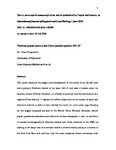Partition, postal services and Ulster unionist politics 1921–27
| dc.contributor.author | Fitzpatrick, C | |
| dc.date.accessioned | 2016-11-11T14:28:13Z | |
| dc.date.accessioned | 2016-11-11T14:44:42Z | |
| dc.date.accessioned | 2016-11-11T15:51:03Z | |
| dc.date.available | 2016-11-11T14:28:13Z | |
| dc.date.available | 2016-11-11T14:44:42Z | |
| dc.date.available | 2016-11-11T15:51:03Z | |
| dc.date.issued | 2016-06-01 | |
| dc.identifier.issn | 2051-4530 | |
| dc.identifier.issn | 2051-4549 | |
| dc.identifier.uri | http://hdl.handle.net/10026.1/6730 | |
| dc.description.abstract |
This article examines the origins and development of the notion of an "all-red" mail route policy in Northern Ireland in the years 1921-27 and what it reveals about the fractious nature of Ulster Unionism, its attitude to partition, and the construction of a separate Ulster identity. It explores the effects of partition on the notions of space and identity in Ireland, as well as how it affected the notion of a state under siege. Drawing on the largely untapped material in the British Postal Museum Archives, cabinet papers, parliamentary debates and local and national newspapers, it aims to contribute to current historiography of Northern Ireland and Ulster unionism in the 1920s by looking at the ways local and sectional interests affected official policy, its attitudes to the Irish Free State and partition, and the more tangential debate concerning both unionist and nationalist perceptions of Northern Ireland’s identity. Finally, it examines the role of post and communications in and its relation to state building in Ireland during this transitional period which has hitherto largely been ignored in Irish history. | |
| dc.format.extent | 31-50 | |
| dc.language | en | |
| dc.language.iso | en | |
| dc.publisher | Taylor & Francis | |
| dc.relation.replaces | http://hdl.handle.net/10026.1/6728 | |
| dc.relation.replaces | 10026.1/6728 | |
| dc.relation.replaces | http://hdl.handle.net/10026.1/6729 | |
| dc.relation.replaces | 10026.1/6729 | |
| dc.subject | 4303 Historical Studies | |
| dc.subject | 43 History, Heritage and Archaeology | |
| dc.subject | 16 Peace, Justice and Strong Institutions | |
| dc.title | Partition, postal services and Ulster unionist politics 1921–27 | |
| dc.type | journal-article | |
| dc.type | Journal Article | |
| plymouth.issue | 1 | |
| plymouth.volume | 11 | |
| plymouth.publication-status | Published | |
| plymouth.journal | International Journal of Regional and Local History | |
| dc.identifier.doi | 10.1080/20514530.2016.1182388 | |
| plymouth.organisational-group | /Plymouth | |
| plymouth.organisational-group | /Plymouth/Faculty of Arts, Humanities and Business | |
| plymouth.organisational-group | /Plymouth/REF 2021 Researchers by UoA | |
| plymouth.organisational-group | /Plymouth/REF 2021 Researchers by UoA/UoA28 History | |
| plymouth.organisational-group | /Plymouth/Users by role | |
| plymouth.organisational-group | /Plymouth/Users by role/Academics | |
| dcterms.dateAccepted | 2016-02-10 | |
| dc.identifier.eissn | 2051-4549 | |
| dc.rights.embargoperiod | Not known | |
| rioxxterms.versionofrecord | 10.1080/20514530.2016.1182388 | |
| rioxxterms.licenseref.uri | http://www.rioxx.net/licenses/all-rights-reserved | |
| rioxxterms.licenseref.startdate | 2016-06-01 | |
| rioxxterms.type | Journal Article/Review |


